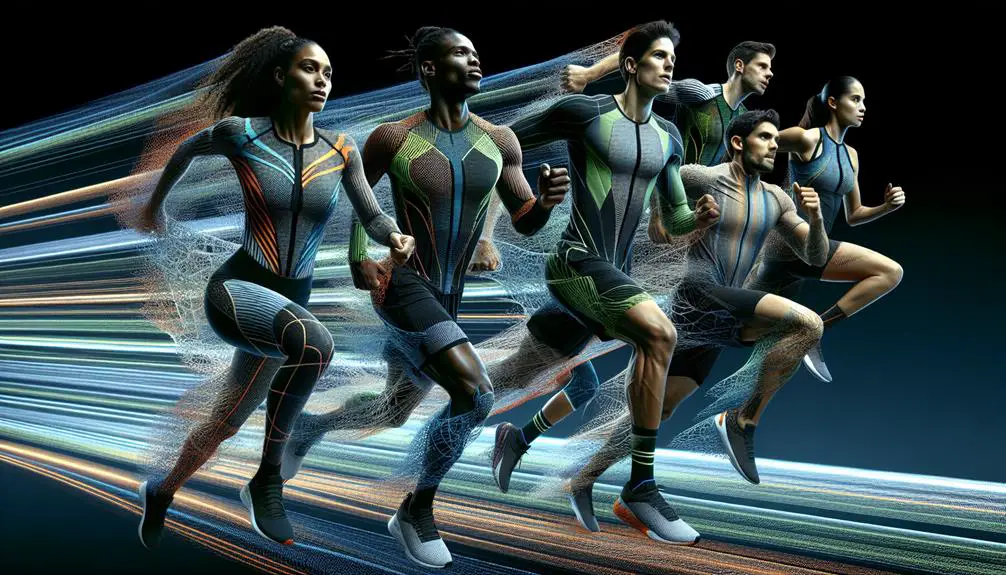Did you know that athletic performance can improve by up to 15% simply by wearing the right engineered fabrics? When you think about moisture-wicking technology, it's more than just keeping you dry; it's about maintaining peak focus and minimizing distractions. Combine that with thermal regulation, and you're looking at a fabric that doesn't just adapt to your body's needs but also enhances your overall performance. But that's just the beginning. There's a lot more to uncover about how these advanced materials can elevate every aspect of your training and competition.
Table of Contents
Key Takeaways
- Moisture-Wicking Technology: Rapid drying and odor-resistant fabrics enhance comfort and performance by keeping athletes dry and irritation-free.
- Thermal Regulation: Advanced materials like Merino wool and neoprene provide both cooling and heat retention for optimal temperature control.
- Durability and Strength: High tear and abrasion resistance ensure fabrics withstand intense activities and protect against impacts and punctures.
- Breathability Features: Innovative weaving and ventilation zones offer superior airflow and moisture control for consistent comfort.
- Sustainable Fabrics: Biodegradable fibers and recycled polyester contribute to eco-friendly performance wear without compromising durability.
Moisture-Wicking Technology
Moisture-absorbing technology keeps you dry by moving sweat away from your skin. This means you stay comfortable even during the most intense workouts. Rapid drying technology guarantees that the sweat isn't only wicked away but also evaporates quickly, leaving you feeling fresh. With odor resistance built into these fabrics, you won't have to worry about unpleasant smells lingering after your exercise session. These features make moisture-absorbing fabrics essential for anyone serious about their training regimen.
Sweat absorption is another crucial aspect. The fabric absorbs moisture effectively, preventing it from pooling on your skin. This is vital because accumulated sweat can lead to skin irritation and discomfort. By efficiently managing sweat absorption, these fabrics help you maintain focus and performance. Additionally, temperature control is enhanced as the fabric regulates the moisture level, making sure you don't overheat or feel clammy.
When you combine these elements, you get a fabric that's engineered for peak performance. The interplay of rapid drying technology, odor resistance, effective sweat absorption, and temperature control offers a complete solution for athletes and fitness enthusiasts. With moisture-absorbing technology, you're equipped to push your limits without compromising on comfort or hygiene.
Thermal Regulation
Consistently maintaining an ideal body temperature is crucial for peak athletic performance. To achieve this, you need fabrics that excel in thermal regulation. Whether you're battling the cold or enduring intense heat, the right material makes all the difference.
Fabrics with superior heat retention and cold resistance keep you comfortable in various conditions. These materials trap your body heat when it's cold and enhance your cooling effects when it's hot. Their insulation properties ensure you stay warm without overheating, and their design promotes optimal airflow to keep you cool during high-intensity activities.
Let's break it down:
| Thermal Needs | Fabric Solution | Benefits |
|---|---|---|
| Cold Resistance | Wool, Fleece | Excellent insulation properties |
| Heat Retention | Neoprene | Superior thermal insulation |
| Cooling Effects | Polyester, Nylon | Enhanced breathability and airflow |
| Dual Purpose | Merino Wool | Adaptable for both warm and cold |
| Active Cooling | Advanced Synthetics | Quick-drying and moisture-wicking |
Durability and Strength
While thermal regulation keeps you comfortable, the durability and strength of your athletic gear guarantee it withstands the rigors of intense activity. When pushing your limits, you need fabrics that offer exceptional abrasion resistance. This quality guarantees that your gear won't wear down easily, even under constant friction.
Equally important is tear strength, which prevents your garments from ripping under stress. Whether you're scaling a rocky cliff or maneuvering through dense woods, high tear strength keeps your gear intact, letting you focus solely on your performance.
Impact resistance is another critical feature. It means your fabric can absorb shocks and blows, protecting you from unexpected impacts. This capability is particularly essential for sports involving physical contact or sudden movements, safeguarding you from injuries.
Puncture resistance is also crucial. Imagine running through a trail with sharp branches or debris; fabrics resistant to punctures prevent these hazards from tearing through your clothing, offering you peace of mind and uninterrupted focus.
In essence, choosing athletic gear engineered with high abrasion resistance, tear strength, impact resistance, and puncture resistance ensures you're well-equipped to tackle any challenge head-on. Your pursuit of excellence deserves nothing less.
Breathability Features
When you're giving it your all, breathable textiles guarantee you stay cool and dry by allowing sweat to escape efficiently. These high-performance materials are engineered for best airflow, ensuring that heat and moisture don't get trapped.
Airflow improvement is essential; it involves thoughtful fabric selection and innovative weaving techniques that enhance breathability. By enabling air to circulate freely, these fabrics help in rapid sweat absorption, which is vital for maintaining comfort during intense activities.
Ventilation design plays a pivotal role in moisture control. Strategically placed ventilation zones, often found in high-sweat areas like the back and underarms, guarantee that the fabric can handle peak perspiration rates. This design not only aids in moisture management but also reduces the risk of chafing and discomfort.
Mastering the balance between breathability and performance, these fabrics incorporate advanced moisture-wicking technologies. They pull sweat away from your skin and push it to the textile's outer layer, where it evaporates quickly. This dual-action approach keeps you dry and cool, allowing you to focus entirely on your performance.
When every second counts, you need a fabric that works as hard as you do, ensuring peak efficiency through superior breathability features.
Flexibility and Stretch
Flexibility and stretch in performance fabrics ensure you move freely and comfortably, no matter the activity. Whether you're scaling a mountain or perfecting your yoga poses, the stretchability comfort of these fabrics guarantees total versatility. They adapt to your movements, providing the freedom you need to excel in any physical endeavor.
Incorporating cutting-edge materials and weaving techniques, flexibility performance is at the forefront of fabric innovation. These advanced textiles are designed to stretch and return to their original shape, maintaining their integrity and support throughout rigorous use. This means you won't experience any sagging or loss of form, even after repeated wear and wash cycles.
The innovation behind these fabrics doesn't end with their ability to stretch. They also boast moisture-wicking properties and enhanced durability, making them ideal for high-intensity activities and everyday wear alike. When you demand the best from your gear, these fabrics deliver with unparalleled performance.
Ultimately, the combination of stretchability comfort and flexibility performance elevates your experience, allowing you to push boundaries and achieve new heights. Embrace the innovation these fabrics offer and maximize your full potential with every move you make.
Lightweight Materials
As you enjoy the freedom of flexible fabrics, you'll also appreciate the advantage of lightweight materials that keep you agile and comfortable. High performance fibers and innovative weaves come together to create fabrics that feel almost weightless while maintaining strength and durability. These materials are engineered to optimize your performance, allowing you to move with ease and efficiency.
Cutting edge polymers play a pivotal role in the development of these lightweight materials. Polymers like polyethylene and polyamide are used to craft fabrics that are not only light but also resilient. Smart textiles further enhance your experience by adapting to your body's needs, regulating temperature, and even wicking away moisture.
Here's a quick comparison of some key lightweight materials:
| Material | Key Features |
|---|---|
| High Performance Fibers | Strength, Durability, Lightweight |
| Innovative Weaves | Flexibility, Breathability, Comfort |
| Cutting Edge Polymers | Resilience, Adaptability, Temperature Regulation |
| Smart Textiles | Moisture Wicking, Thermal Control, Adaptiveness |
UV Protection
When considering UV protection, you'll appreciate advanced UV-blocking technologies that guarantee your skin stays safe under intense sunlight.
These fabrics aren't just protective; they also maintain their durability even after prolonged exposure to the sun.
This combination is key to achieving peak performance without compromising safety or fabric integrity.
Advanced UV-Blocking Technologies
Modern engineering fabrics now incorporate advanced UV-blocking technologies to offer superior protection against harmful ultraviolet rays. Leveraging nanotechnology applications and cutting-edge research, these fabrics are designed to shield your skin while maintaining comfort and breathability. By embedding microscopic particles into the fabric, manufacturers enhance UV absorption and reflection, ensuring you stay safe under the sun.
Innovative techniques in fabric design have led to textiles that provide up to 99% UV protection without compromising on style or functionality. These advanced fabrics aren't only effective but also lightweight and flexible, making them perfect for active wear and outdoor activities.
Incorporating these technologies into your wardrobe means you can enjoy the outdoors with peace of mind. Here are some key benefits:
- Enhanced UV Protection: Blocks up to 99% of harmful rays.
- Long-lasting Effectiveness: UV-blocking properties that don't wash out.
- Comfort: Breathable and moisture-wicking to keep you cool and dry.
- Versatility: Suitable for various fabric types and styles.
Fabric Durability Under Sun
To guarantee your garments maintain their protective qualities, it's important to assess how well the fabric withstands prolonged exposure to the sun. High UV resistance is essential for fabrics designed to protect you from harmful ultraviolet rays. Over time, exposure to sunlight can degrade materials, reducing their effectiveness and longevity. You need fabrics that don't just block UV rays initially but continue to do so after extensive wear and exposure.
To make sure you select the best materials, thorough fabric testing is vital. This process involves exposing samples to simulated sunlight for extended periods and then evaluating their UV resistance. These tests measure how much UV radiation the fabric can block after being subjected to these conditions. Fabrics that maintain their blocking capabilities are considered superior.
You also want to look for fabrics treated with UV inhibitors. These additives enhance the material's ability to resist degradation from sunlight. By understanding the importance of fabric testing and UV resistance, you can confidently choose garments that offer sustained protection.
Investing in high-quality, UV-resistant fabrics means your clothing will serve you well, even under the harshest sun conditions.
Sustainable Fabrics
When you consider sustainable fabrics, think about eco-friendly material innovations and renewable textile sources.
You can choose fabrics made from recycled materials or those derived from plants.
These options don't just benefit the environment; they also offer high performance.
Eco-friendly Material Innovations
Pioneering eco-friendly material innovations, engineers are transforming the fabric industry with sustainable options that don't compromise performance. You're likely aware that sustainable fabrics are gaining traction, and for good reason. They offer the dual benefit of high performance and environmental responsibility.
Biodegradable fibers are at the forefront, breaking down naturally and reducing landfill waste. Imagine apparel that returns to the earth without leaving a trace.
Recycled polyester is another game-changer, repurposing plastic waste into high-quality, durable fabrics. This not only minimizes environmental impact but also conserves resources.
Organic cotton stands out for its minimal use of pesticides and synthetic fertilizers. It's not just kinder to the planet; it also offers superior softness and breathability.
Bamboo fabric is another rising star, prized for its rapid growth and minimal land use. It's naturally antibacterial, moisture-wicking, and incredibly soft.
These innovations collectively underscore a commitment to sustainability while delivering peak performance. Consider these highlights:
- Biodegradable fibers: Break down naturally.
- Recycled polyester: Repurposes plastic waste.
- Organic cotton: Minimizes pesticide use.
- Bamboo fabric: Naturally antibacterial and soft.
Renewable Textile Sources
Building on these eco-friendly innovations, renewable textile sources are setting new benchmarks in sustainable fabric engineering. By leveraging natural fibers, you can significantly decrease your environmental impact. Hemp, bamboo, and organic cotton are exemplary in this regard, offering not only superb durability but also biodegradability. These materials break down without leaving harmful residues, making them superior to synthetic alternatives.
Imagine crafting a garment that doesn't just perform well but also contributes to sustainability. That's the promise of biodegradable textiles. They decompose naturally, minimizing landfill waste and creating a circular lifecycle. As you explore further into sustainable fabric engineering, you'll discover how these textiles can revolutionize the industry.
Here's a quick comparison to guide your choices:
| Material | Durability | Biodegradability | Environmental Impact |
|---|---|---|---|
| Hemp | High | Excellent | Low |
| Bamboo | Medium | Good | Low |
| Organic Cotton | Medium | Excellent | Low |
| Polyester | High | Poor | High |
Frequently Asked Questions
How Do Engineered Fabrics Affect Skin Allergies?
Engineered fabrics can lessen skin irritation. If you have fabric sensitivities, opt for hypoallergenic options. Taking preventative measures with these specialized materials helps you avoid skin allergies and enjoy greater comfort.
What Are the Best Practices for Washing Performance Fabrics?
You should follow specific washing guidelines for performance wear. Opt for cold water, gentle cycles, and mild detergents. Avoid fabric softeners and high heat drying. These laundry tips guarantee proper fabric care and prolong garment life.
Can Engineered Fabrics Be Recycled Effectively?
You can recycle engineered fabrics effectively, but it's important to understand their recycling efficiency. By doing so, you minimize the environmental impact and contribute to a sustainable future. Mastering recycling techniques guarantees the best use of resources.
How Do These Fabrics Impact Overall Athletic Performance?
You'll see a significant boost in athletic performance thanks to breathability benefits and moisture-wicking technology. These fabrics keep you cool and dry, allowing peak endurance and comfort during intense workouts, enhancing your overall results.
Are There Any Specific Certifications for High-Performance Fabrics?
Oh, you think high-quality fabrics just magically achieve greatness? No, they undergo rigorous testing. Certifications and standards like ISO and ASTM guarantee exceptional performance and quality assurance. It's all about maintaining those elite benchmarks.
- Tetron Fabric for Marine Applications: Durability and Use Cases - June 18, 2025
- Tetron Fabric for Outdoor Furniture: Weather Resistance and Care - June 18, 2025
- Tetron Fabric for Wall Coverings: Style and Application Tips - June 18, 2025







